For companies that provide medical services, optimizing patient care is a top priority. However, patients are not only individuals in need of treatment but also consumers in a vast and diverse healthcare market with specific requirements and expectations. To meet ever-increasing demands and remain competitive, companies must pay attention to numerous small details in addition to solving health problems. Patient management software offers a solution by streamlining many administrative tasks related to patient interactions. Today, we’ll explore what features make these systems indispensable and how developers can implement them.
What is Patient Management Software?
Patient management software is intended to help both parties involved in the provision of medical services.
- For companies, it improves the way staff manages patient information and administrative tasks.
- For patients, it simplifies each step of getting medical help, from booking the doctor appointment to paying for services rendered.
These solutions can replace dozens of separated apps and serve as a centralized software solution for handling a wide range of patient-related activities, from diagnosis tracking to billing and appointment scheduling.
One of the primary goals of adopting patient management software is to automate and streamline various administrative processes that are too time-consuming when performed manually. Digitizing patient data can be a first step in this journey. It’s a straightforward yet effective way of simplifying the management of tons of data with a low risk of human errors. Further automation not only saves time but also enhances the patient experience by minimizing waiting times and ensuring timely communication of lab results, diagnoses, and upcoming appointments.
Read Also EHR Software Development. Saving People’s Health by Electronic Means
Patient management software works not only on an individual level but also modernizes the industry as a whole. By integrating various functionalities, such as patient follow-up, payment processing, and administrative tasks automation, they help companies stay responsive to the customers’ needs that always grow and maintain service provision at a high level.
Why the Need for Patient Management Systems Has Become Urgent
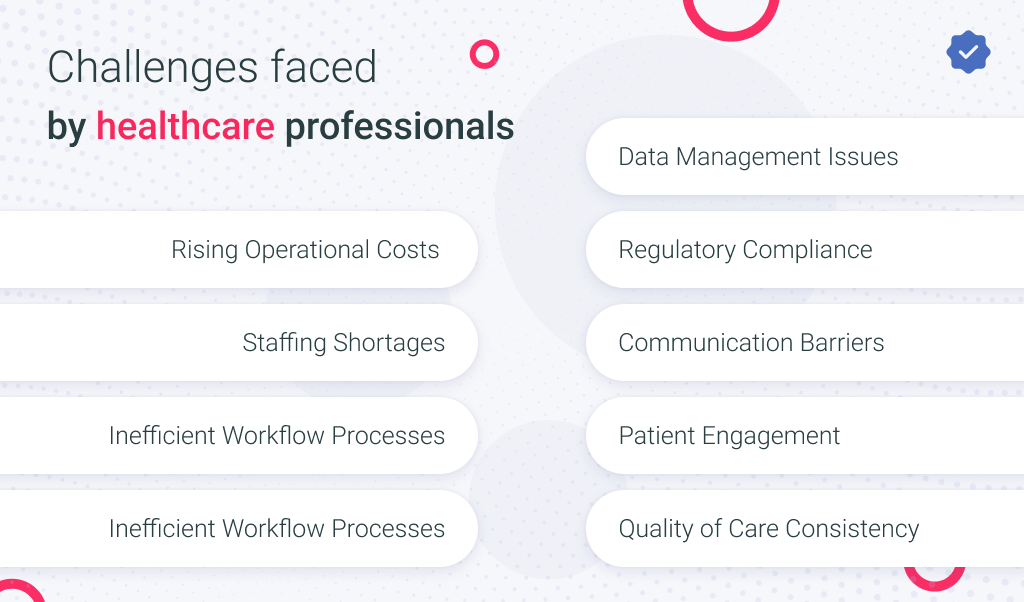
The need for such systems does not appear out of nowhere. The healthcare industry is not only about healing people. Running a company that provides medical services is a complex and multifaceted endeavor, often fraught with administrative challenges. The most common issues faced by healthcare practices include high costs, irregular patient visits, ineffective procedures, and workforce shortages. For example, there is a projected shortfall of 9.9 million healthcare professionals globally by 2030. All these factors combined lead to a necessity to increase the efficiency of medical companies by all means possible.
Manually managed patient data records can be prone to errors and inconsistencies, while insufficient and unreliable medical history documentation can compromise clinical decision-making. The inability to seamlessly exchange data between departments or locations can make things even worse. It can lead to delays in communication, lack of timely treatment modifications, and convoluted payment procedures involving multiple insurance providers.
These systemic inefficiencies eventually result in long wait times and low-quality patient care. In an era where patients are increasingly empowered and discerning, this can have a detrimental impact on a company’s reputation and ability to attract and retain clients. The intention of potential customers to check online reviews before applying for services makes it difficult for companies to hide their mistakes and inefficiencies.
Key Features of Patient Management Systems
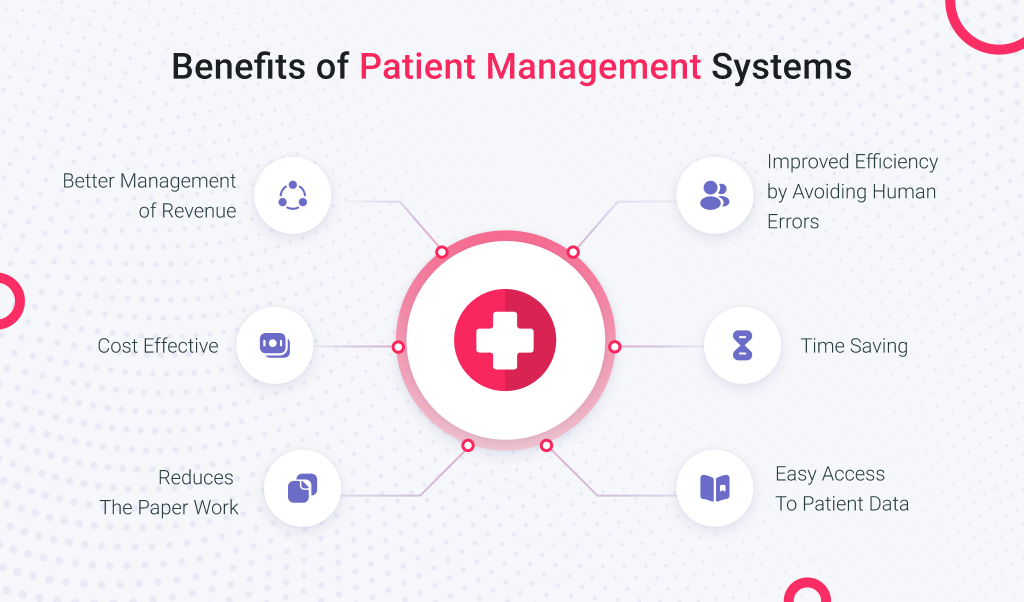
Here, we’ll discuss how exactly patient management software helps businesses address all the challenges we’ve mentioned above. We’ll rely on our experience in healthcare software development to illustrate what some of the described features may look like in real life.
Read Also These 7 Healthcare Systems Can Bring Your Business Luck and Prosperity
Effective Medical Records Management
A major benefit of patient management systems is reducing the administrative burden on healthcare workers, allowing them to focus on patient care. Central to this is effective medical records management. PMS software enables healthcare facilities to store, monitor, access, and archive patient data seamlessly. It encompasses everything from medical histories to prescriptions and lab results.
With a single click, medical staff can generate documents, send bulk communications to patient groups, or automated appointment reminders. This capability significantly cuts down on time and effort, enabling front-desk personnel to dedicate more attention to patient interactions, fostering a more welcoming and patient-focused environment.
Example: Online Medical Appointment Scheduling Software
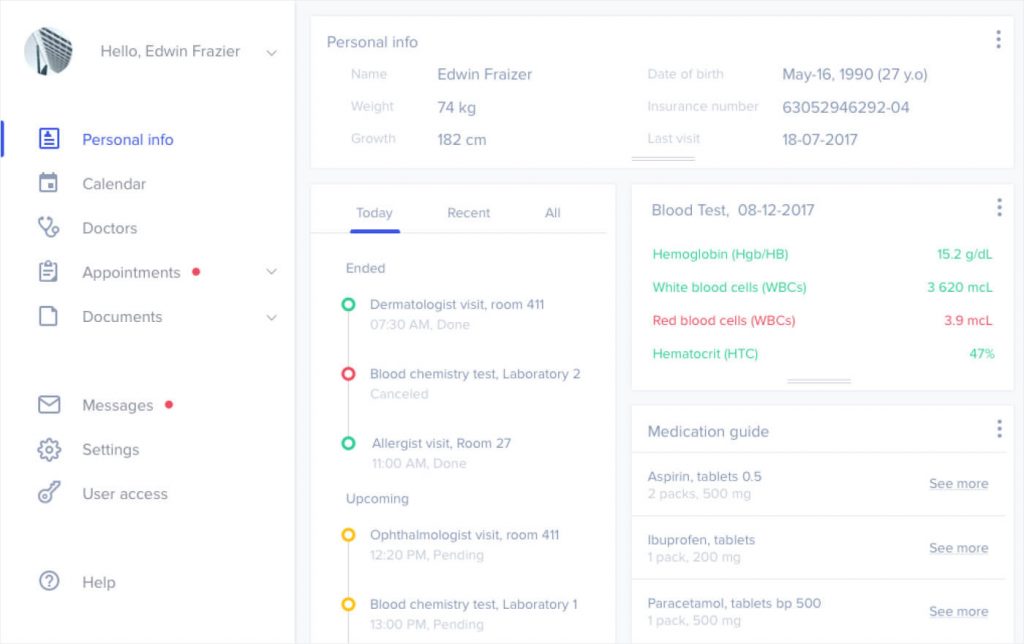
Benefits:
- Reduced Administrative Burden. Frees up healthcare workers to focus more on patient care.
- Seamless Data Management. Efficiently store, monitor, access, and archive patient data, including medical histories, prescriptions, and lab results.
- Quick Document Generation. Generate necessary documents with a single click.
- Enhanced Patient Interaction. Allows front-desk personnel to dedicate more attention to patients, creating a more welcoming environment.
Billing and Payment Made Simple
One of the critical features of a robust patient management software is its ability to optimize billing and payment processes. By automating financial operations, you can reduce billing errors and ensure timely payment collections.
Such a system can manage all past and current patient payment data, ensuring accurate billing and prescription tracking. It can automatically verify insurance eligibility during check-in and automate the billing cycle, from the first point of contact to final payment, improving the efficiency of revenue collection and reducing the risk of financial discrepancies.
Benefits:
- Reduced Billing Errors. Automation minimizes errors in billing.
- Timely Payment Collections.
- Comprehensive Payment Data Management. Manages all past and current patient payment data accurately.
- Accurate Billing and Prescription Tracking.
- Insurance Eligibility Verification made automatically during check-in.
- Automated Billing Cycle. Streamlines the entire billing process from initial contact to final payment.
Appointment Scheduling
In today’s digital world, 68% of patients prefer medical providers that offer the ability to make appointments online, and patient management systems make this process easy and efficient. These systems allow patients to see doctor availability and schedule appointments directly, eliminating the need for phone calls and reducing administrative workload. Moreover, the system enables healthcare providers to reduce no-shows through proactive communication and efficient calendar management, optimizing both time and resources.
Example: Online Medical Appointment Scheduling Software
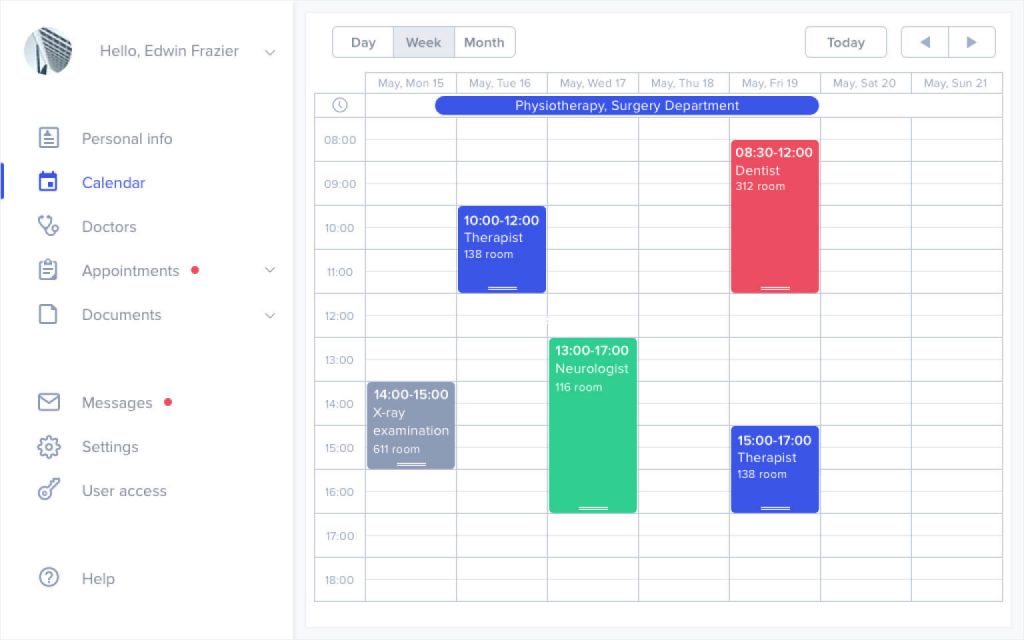
Benefits:
- Increased Patient Satisfaction.
- Direct Scheduling. Patients can see doctor availability and book appointments directly, eliminating the need for phone calls.
- Reduced Administrative Workload. Lessens the burden on administrative staff by automating the scheduling process.
- Proactive Communication. Helps reduce no-shows through timely reminders and updates.
- Efficient Calendar Management. Optimizes the use of time and resources by managing appointments effectively.
- Resource Optimization. Ensures better utilization of healthcare providers’ time and resources.
Building Patient Loyalty and Compliance with Automated Reminders
A loyal patient base is essential for any healthcare provider, both for maintaining revenue and for ensuring consistent, high-quality care. Patient management software plays a vital role in this area by sending automated reminders for upcoming appointments, routine check-ups, payment deadlines, or even the time of taking medications. This functionality fosters stronger patient-provider relationships and improves adherence to care plans, which can lead to better health outcomes.
Example: Healthcare Messaging Application
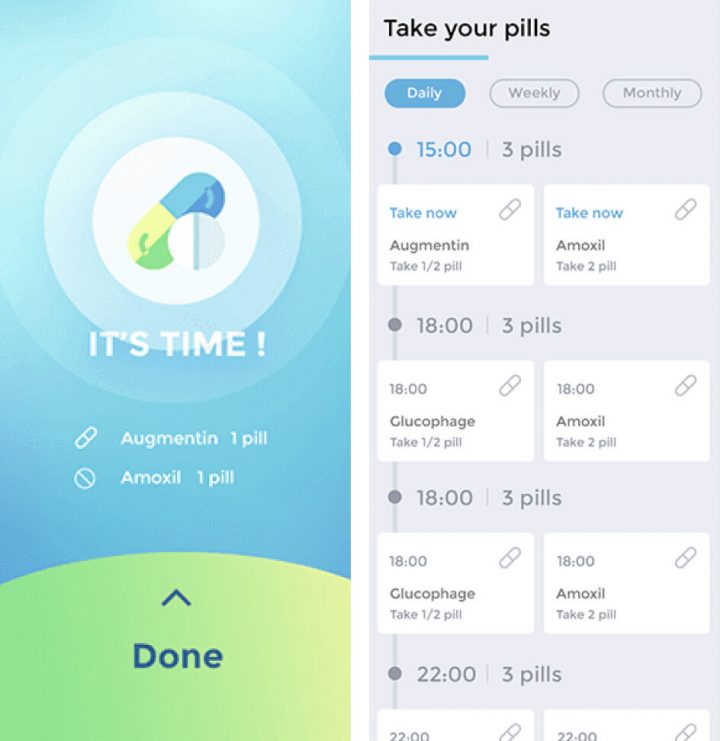
Benefits:
- Stronger Patient-Provider Relationships. Enhances relationships through proactive communication.
- Improved Adherence to Care Plans. Encourages patients to follow their care plans more closely.
Advanced Healthcare with Data Analytics
Data is one of the most valuable assets in healthcare, and PMS platforms are equipped to harness it effectively. By integrating data from various sources such as electronic health records, patient portals, and connected medical devices, these systems provide healthcare professionals with comprehensive insights into patient health trends. Through advanced analytics, healthcare providers can generate reports on care coordination, population health, and more—helping to create personalized communication and care plans tailored to individual needs.
Example: Migraine Tracking App
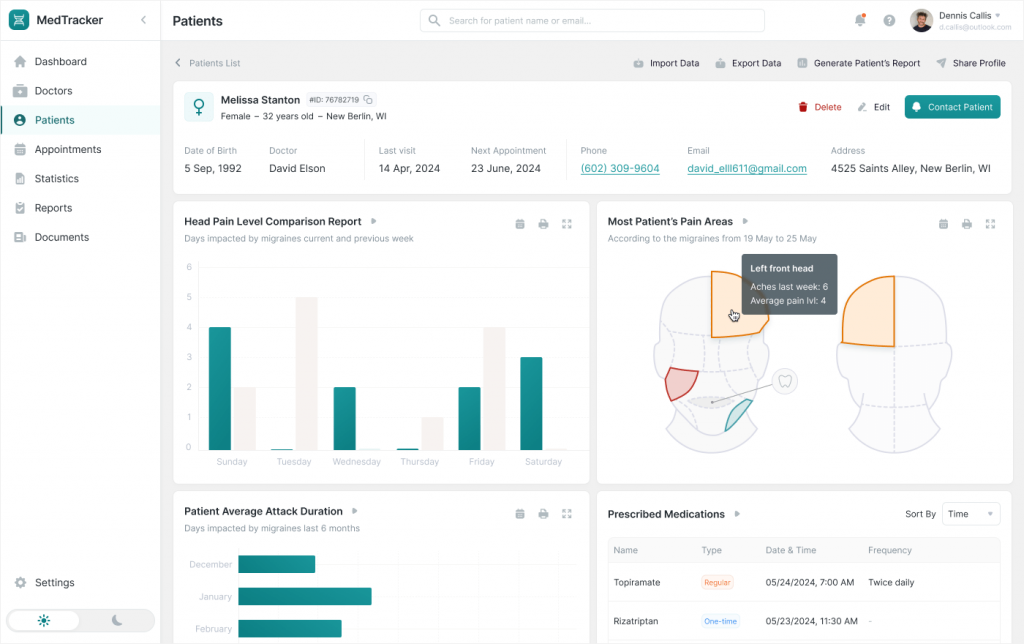
Benefits:
- Comprehensive Data Integration. Integrates data from electronic health records, patient portals, and connected medical devices.
- Enhanced Patient Insights. Provides healthcare professionals with detailed insights into patient health trends.
- Advanced Analytics. Utilizes advanced analytics to generate reports on care coordination and population health.
- Personalized Communication. Enables the creation of personalized communication plans tailored to individual patient needs.
Our Expertise
We often use Webix and DHTMLX libraries in our projects. They include components with rich out-of-the box functionality which allows us to cut costs on customizing and integrating them into the apps. Here, we’ll consider which of these components allow us to build top-notch healthcare software solutions for those clients who decided to reap all the benefits of adopting custom-made software.
To help patient management software users handle records effectively, we can use the following components:
- Webix DataTable and DHTMLX Grid. Both libraries offer powerful grid components that are ideal for handling large datasets, such as patient records. These grids allow medical staff to sort, filter, and search patient information quickly. Features like inline editing, frozen columns, and responsive design ensure seamless management and retrieval of records on various devices.
- Webix File Manager and DHTMLX Vault enable secure file storage and management for handling medical documents like prescriptions, lab results, and medical histories. Both allow medical staff to upload, download, and organize files, ensuring all medical records are centralized and easy to access.
- Webix Form and DHTMLX Form are form components that simplify data entry and update processes. Healthcare providers can use them to create forms for patient intake, medical history updates, and other critical data collection, ensuring that all records are updated efficiently.
For billing and payments, our main helpers are:
- Webix Spreadsheet and DHTMLX Spreadsheet that offer a familiar spreadsheet interface to handle complex calculations and data tracking for billing. By integrating them into the patient management software, financial records can be easily maintained, with automated formulas calculating costs, insurance claims, and patient payments.
- Webix Pivot and DHTMLX Pivot Table help analyze revenue streams by organizing data into customizable reports. Healthcare administrators can use them to track patient payment histories, outstanding balances, and revenue trends, allowing them to make informed financial decisions.
For efficient appointment scheduling, we can rely on Webix Scheduler and DHTMLX Scheduler. Both libraries offer robust scheduling components that can be integrated into the patient management software to manage doctor availability, patient appointments, and clinic resources. Patients can view available time slots and book appointments directly through the interface. These schedulers allow for drag-and-drop rescheduling, color-coded events for different types of appointments, and even integration with other calendar systems like Google Calendar or Outlook.
To visualize data in an easy-to-understand way, we can use:
- Webix Charts and DHTMLX Charts. Whether tracking patient visits, monitoring recovery rates, or analyzing financial data, these charts help build software that converts raw data into actionable insights. Webix and DHTMLX support various chart types like bar, line, pie, and radar charts, allowing healthcare professionals to visualize data trends effectively.
- Webix Dashboard and DHTMLX Dashboards. These components help us create software with customizable dashboards that provide real-time insights into key metrics such as appointment scheduling efficiency, patient satisfaction, and clinic performance. Dashboards can be tailored to specific roles, ensuring that healthcare administrators and practitioners have the data they need at their fingertips.
Conclusions
The burden of routine administrative tasks can sometimes shift the focus away from what’s truly important for the business. Adopting patient management software can help companies that provide medical services focus on what matters most: healing people. Searching for the medical records of a patient who hasn’t visited in years won’t take hours just because a folder fell behind a filing cabinet. With patient management software, all the important data is just a few clicks away for the medical staff. Contact us to learn more about the different types of healthcare software solutions we build, and we’ll help you find the one that works best for you.